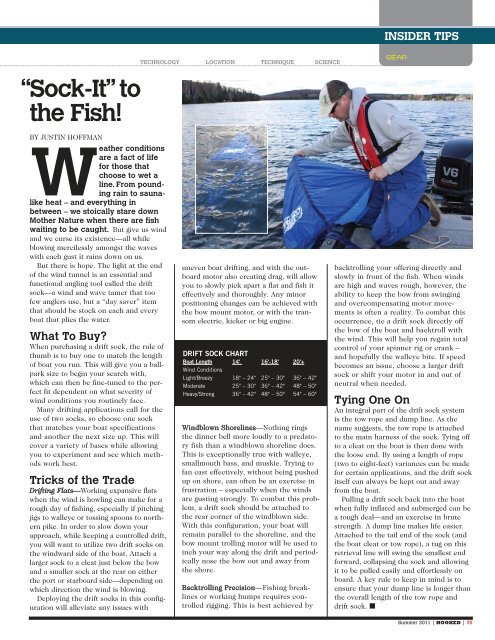Hooked 0403_Hooked 0403- - Hooked Magazine
Hooked 0403_Hooked 0403- - Hooked Magazine
Hooked 0403_Hooked 0403- - Hooked Magazine
You also want an ePaper? Increase the reach of your titles
YUMPU automatically turns print PDFs into web optimized ePapers that Google loves.
“Sock-It” to<br />
the Fish!<br />
BY JUSTIN HOFFMAN<br />
Weather conditions<br />
are a fact of life<br />
for those that<br />
choose to wet a<br />
line. From pounding<br />
rain to saunalike<br />
heat – and everything in<br />
between – we stoically stare down<br />
Mother Nature when there are fish<br />
waiting to be caught. But give us wind<br />
and we curse its existence—all while<br />
blowing mercilessly amongst the waves<br />
with each gust it rains down on us.<br />
But there is hope. The light at the end<br />
of the wind tunnel is an essential and<br />
functional angling tool called the drift<br />
sock—a wind and wave tamer that too<br />
few anglers use, but a “day saver” item<br />
that should be stock on each and every<br />
boat that plies the water.<br />
What To Buy?<br />
When purchasing a drift sock, the rule of<br />
thumb is to buy one to match the length<br />
of boat you run. This will give you a ballpark<br />
size to begin your search with,<br />
which can then be fine-tuned to the perfect<br />
fit dependent on what severity of<br />
wind conditions you routinely face.<br />
Many drifting applications call for the<br />
use of two socks, so choose one sock<br />
that matches your boat specifications<br />
and another the next size up. This will<br />
cover a variety of bases while allowing<br />
you to experiment and see which methods<br />
work best.<br />
Tricks of the Trade<br />
Drifting Flats—Working expansive flats<br />
when the wind is howling can make for a<br />
tough day of fishing, especially if pitching<br />
jigs to walleye or tossing spoons to northern<br />
pike. In order to slow down your<br />
approach, while keeping a controlled drift,<br />
you will want to utilize two drift socks on<br />
the windward side of the boat. Attach a<br />
larger sock to a cleat just below the bow<br />
and a smaller sock at the rear on either<br />
the port or starboard side—depending on<br />
which direction the wind is blowing.<br />
Deploying the drift socks in this configuration<br />
will alleviate any issues with<br />
TECHNOLOGY LOCATION TECHNIQUE SCIENCE<br />
uneven boat drifting, and with the outboard<br />
motor also creating drag, will allow<br />
you to slowly pick apart a flat and fish it<br />
effectively and thoroughly. Any minor<br />
positioning changes can be achieved with<br />
the bow mount motor, or with the transom<br />
electric, kicker or big engine.<br />
DRIFT SOCK CHART<br />
Boat Length 14' 16'-18' 20'+<br />
Wind Conditions<br />
Light/Breezy 18" – 24" 25" – 30" 36" – 42"<br />
Moderate 25" – 30" 36" – 42" 48" – 50"<br />
Heavy/Strong 36" – 42" 48" – 50" 54" – 60"<br />
Windblown Shorelines—Nothing rings<br />
the dinner bell more loudly to a predatory<br />
fish than a windblown shoreline does.<br />
This is exceptionally true with walleye,<br />
smallmouth bass, and muskie. Trying to<br />
fan cast effectively, without being pushed<br />
up on shore, can often be an exercise in<br />
frustration – especially when the winds<br />
are gusting strongly. To combat this problem,<br />
a drift sock should be attached to<br />
the rear corner of the windblown side.<br />
With this configuration, your boat will<br />
remain parallel to the shoreline, and the<br />
bow mount trolling motor will be used to<br />
inch your way along the drift and periodically<br />
nose the bow out and away from<br />
the shore.<br />
Backtrolling Precision—Fishing breaklines<br />
or working humps requires controlled<br />
rigging. This is best achieved by<br />
INSIDER TIPS<br />
GEAR<br />
backtrolling your offering directly and<br />
slowly in front of the fish. When winds<br />
are high and waves rough, however, the<br />
ability to keep the bow from swinging<br />
and overcompensating motor movements<br />
is often a reality. To combat this<br />
occurrence, tie a drift sock directly off<br />
the bow of the boat and backtroll with<br />
the wind. This will help you regain total<br />
control of your spinner rig or crank –<br />
and hopefully the walleye bite. If speed<br />
becomes an issue, choose a larger drift<br />
sock or shift your motor in and out of<br />
neutral when needed.<br />
Tying One On<br />
An integral part of the drift sock system<br />
is the tow rope and dump line. As the<br />
name suggests, the tow rope is attached<br />
to the main harness of the sock. Tying off<br />
to a cleat on the boat is then done with<br />
the loose end. By using a length of rope<br />
(two to eight-feet) variances can be made<br />
for certain applications, and the drift sock<br />
itself can always be kept out and away<br />
from the boat.<br />
Pulling a drift sock back into the boat<br />
when fully inflated and submerged can be<br />
a tough deal—and an exercise in brute<br />
strength. A dump line makes life easier.<br />
Attached to the tail end of the sock (and<br />
the boat cleat or tow rope), a tug on this<br />
retrieval line will swing the smallest end<br />
forward, collapsing the sock and allowing<br />
it to be pulled easily and effortlessly on<br />
board. A key rule to keep in mind is to<br />
ensure that your dump line is longer than<br />
the overall length of the tow rope and<br />
drift sock. ■<br />
Summer 2011 | HOOKED | 35


